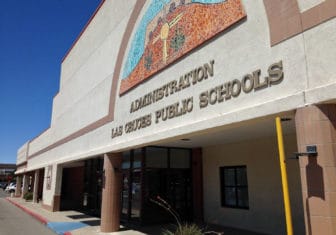COMMENTARY: Budget woes in the Las Cruces Public Schools have been a hot topic lately, particularly since superintendent Stan Rounds has announced that teachers will be furloughed for three days next school year.

Courtesy photo
Del Hansen
It seems that the district has found itself in a funding crunch, and reducing staff and requiring the ones who are left to go without pay for three days will help ease the problem.
According to Rounds, the district has allowed staff compensation to grow to about 91 percent of the budget, when a more manageable number would be about 84 percent.
A good question might be why $188 million is not enough money to keep the district in the black? Before one can answer that, it would be helpful to know how the state arrives at that figure in the first place.
How we fund schools
In 1974 the New Mexico Legislature created what was, at that time, the most innovative way of distributing money to schools in the United States. In decades preceding 1974, there were rich districts and very poor districts in the state, creating considerable inequity in curriculum delivery and teacher compensation. As a result of the equalization guarantee crafted by the Legislature and public education office, money was shifted around to put all New Mexico districts on a more equal footing.

Heath Haussamen / NMPolitics.net
The Las Cruces Public Schools administration building.
In many school districts around the country, property taxes remain the principal source of revenue for schools. This is not so in New Mexico. Here, funding for schools is primarily derived from the sales tax, personal income taxes, and severance taxes based on oil, gas, and mineral extraction.
In a stroke of prescient genius in the 70s, the Legislature decided to establish a permanent fund based on severance taxation and land grant revenues, and the interest and draw upon this source accounts for a significant part of revenue for education in New Mexico.
During the past four decades, the percentage of the revenue pie going to both public schools and higher education has steadily decreased from about 51.5 percent of the budget in 1988 to the current 34 percent. During this time period, the size of the whole pie increased proportionately as the state grew in population and additional revenue sources were tapped.
Depending on the audience to whom one speaks, the argument can be made that the state has reduced the importance of spending on education over the past 30 years, while recent statements have extolled the fact that more money is now spent on education than ever before. There is some truth in both.
Dollars based on state revenues
The funding equalization/guarantee formula is ingenious, converting student enrollment into “units” that can be multiplied by various preset factors to produce a total amount of funding necessary to educate the children of a district.
For instance, fourth through sixth graders are approximately weighted as “1.0.” A thousand sixth graders would be worth one thousand units. Seventh through twelfth graders are weighted 1.25, so a thousand students in this category would be worth 1,250 units. D level special needs students are weighted 2.00, so a thousand of these children would be worth 2,000 units.
There are other special add-on factors as well, such as bilingual students at an additional .50 unit. There are additional subcategories beyond these.
All of these units are totaled, producing a number that will be larger than the actual enrollment of the district. When these units are multiplied by the per-student-allocation, as determined by the state budget based on benchmarks for the previous school year, the funding for a school district is set. This is modified at the 40th, 80th, and 120th days to reflect changes in student population.
Interestingly, one might think that the state would add up all the units, multiply by the per-student-allocation, and determine the amount of money needed to run the schools, which then would be appropriated by the Legislature. This isn’t entirely the case.
The Legislature first appropriates a dollar figure, and by working backward through the units over the state, the per-student-allocation is finalized. This is a floating figure and may increase or decrease from year to year, depending on state revenues. This technique takes the guess work out of trying to predict the number of units each year.
Drawn-down reserves
So this brings us to the budget woes in Las Cruces and in other districts around the state. Superintendent Rounds is duly concerned that the budgetary reserves for the district are very low, less than 2 percent of total income. Actually, over the past 30 years the percentage of reserves has fallen dramatically from about 6 percent or 7 percent to the current much lower figure.
In order to not raise taxes in years past, the Legislature authorized the public education department to allow districts to draw down their reserves, using that money for raises and additional unforeseen costs. However, one can rob the piggy bank only so many times. The problem is the money coming from these sources was used to fund recurring expenses, and so when that revenue became exhausted, a hole developed that could not easily be filled without additional state money.
Throw in new mandates from the PED and gubernatorial prerogatives such as merit pay, and there’s trouble right there in River City, borrowing a line from the Music Man.
Massive standardized testing requirements implemented as educational reform during the past several years has severely impacted the very narrow “wiggle room” with which superintendents had to work. Quantum leaps in insurance costs and dwindling reserves compel district administrators to consider serious, if not Draconian, measures to balance the budget.
New high schools
In Las Cruces, the board, on the advice of the superintendent, embarked on an ambitious building program, adding one large new comprehensive high school and two new early college high schools in a matter of a few years. Clearly, this money was bonded and matched and was not operational funding. However, there are very large, looming operational considerations in the start-up and continuance of these additions to the budget.
When the community’s population growth suddenly slowed to a trickle, the budget was in trouble. Massive building programs work well in the light of an expanding student population, which produces additional units. When units are flat-lined or increasing minimally, new programs must be balanced by cuts elsewhere.
The budget crisis in Las Cruces and other New Mexico communities didn’t sneak up on anyone. It was a lumbering buffalo clomping through the glassware store. Eventually, something would break. Furloughs and program cuts are tried and true ways to reduce budget lines, but they don’t exactly inspire confidence in school staff and in the community as a whole.
The next big question is: Why isn’t $188 million enough to educate 24,000 students in Las Cruces?
Hansen is retired from a 40-year career in education, having been a teacher of math and physics and an administrator. He has earned local and state recognition for teaching and administration. He is married to Donna McCoskey Hansen and resides in Las Cruces.